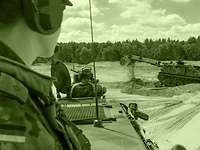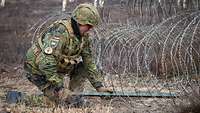The engineers are part of the combat support forces of the German Army.
Being an engineer means braving the unknown, courageously tackling the new, taking point in situations in which the way ahead demands a keen eye for the feasible, boldness and hands-on proficiency.
The Army Corps of Engineers has a personnel strength of around 6,200 active-duty soldiers.
The engineers support friendly forces during operations at home and abroad, providing soldiers trained for construction work and technical operations as well as special vehicles, machinery, equipment and tools. The branch is headed by the Director, Corps of Engineers, who is also the Commandant of the Engineer Training Centre and Army School of Construction Engineering, the central training facility for all Bundeswehr engineers.
Mobility and countermobility operations
The purpose of mobility operations on land is to maintain or enhance tactical mobility. The Corps of Engineers facilitates friendly movements when crossing and breaching barriers and obstacles. Its soldiers breach minefields, clear explosive ordnance, remove debris and barricades after destruction due to war or natural disasters, and build march routes and bridges. To do their jobs, engineers employ mine-clearing tanks, explosive ordnance disposal equipment, armoured engineer vehicles, different types of bridging equipment, construction machinery and a variety of special tools.
Engineers also impede and canalise movements of military adversaries. The Corps of Engineers can render important terrain sections, roads and bridges temporarily or permanently impassable. Using armoured engineer vehicles, antitank mines and explosives, engineers can block important terrain sections, roads and bridges.
Identifying and eliminating hazards
Engineers are trained to search for and identify mines, improvised explosive devices and ordnance on land and in inland waters. Specially trained soldiers of the Corps of Engineers and engineer divers can neutralise or clear identified hazards.
The Corps of Engineers uses various types of special equipment to detect and clear mines and improvised explosive devices, such as remote-controlled reconnaissance vehicles and remote-controlled manipulator vehicles, special explosives and a variety of special tools. The Corps of Engineers also includes dogs specially trained to detect mines and explosive ordnance.
Increasing survivability
Engineer forces improve force protection, thus increasing survivability for friendly forces. In urban terrain, engineers repair infrastructure and carry out construction work to reinforce and fortify facilities used for military purposes. In undeveloped terrain, engineers build field fortifications and other types of cover to protect soldiers and military vehicles against direct and indirect fires, individual attackers, and direct attacks.
With their wide variety of skills and equipment, engineers are particularly capable of overcoming the special challenges inherent in modern, usually multinational operations. Engineers have proven their mettle on numerous operations abroad.















